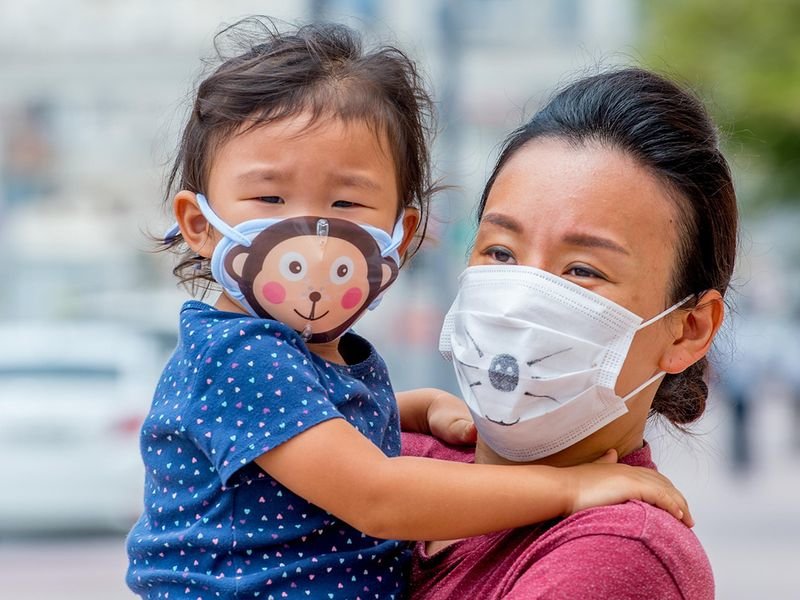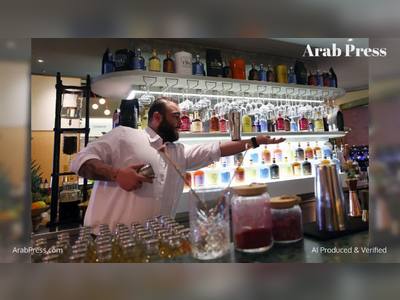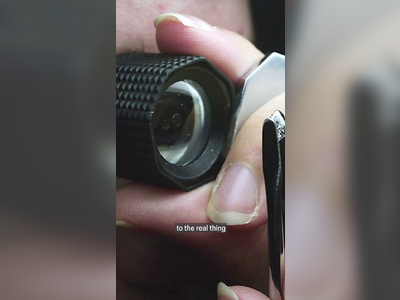
COVID-19: What is the best mask to wear? Should I wear two at a time?
After some initial debate about their efficacy and need, face masks are now a regular part of the COVID-19 normal. These items of personal protective equipment have become ubiquitous, and also known to be one of the most important instruments at limiting the spread of the coronavirus.
In the UAE, everyone over the age of six years must be wearing face masks when stepping outside the home, and the Ministry of Health and Prevention recommends face masks for children two years and older. Neglecting to wear a face mask is also now a punishable offence, with a Dh3,000 fine slapped on violators.
As residents seek to best protect themselves from COVID-19, many have also taken to wearing more than one mask when heading out. There could however be risks with improperly wearing masks.
Gulf News spoke to Dr Trilok Chand, respiratory medicine specialist at Burjeel Hospital Abu Dhabi, and Dr Arun Arya, head of pulmonology and internal medicine at NMC Royal Hospital, Khalifa City, to find out all the do’s and don’ts of mask-wearing.
Types of masks
For this piece, masks have been broadly divided into three basic categories:
Surgical masks: These are made of multiple layers of non-woven fabric, and are mainly effective against large particles. Surgical masks are fluid and spray-resistant, but have to be disposed in a closed bin after each use.
N95 masks: These are respirator masks with a tight seal. They filter the air, and prevent small contaminated particles from entering the mouth or nasal passage. N95s get their name because they provide protection from 95 per cent of small particles measuring up to 0.3 microns.
Cloth masks: These are made of layers of fabric, typically cotton, and must be washed after every use.
How effective are disposable masks — surgical or N95 — at stopping the spread of COVID-19?
The most common means of human-to-human transmission of the COVID-19 virus is through droplets released while coughing or sneezing. While large droplets can travel up to three metres, fine droplets may travel up to a distance of six metres and remain suspended in the air for at least 10 minutes. The particles can [also] stay suspended for several hours in a closed space.
So it is crucial that we wear a mask to protect ourselves from contracting the virus. It has been found that a surgical mask can ensure around 75 to 80 per cent protection from infected droplets, while N95 masks enable 99 per cent protection.
But in addition to wearing a mask, it is also important that people maintain social distancing of at least two metres with people outside one’s household, and avoid close contact with those suspected to be infected. This is because you could still catch the virus through the membranes in your eyes, a risk that masking does not eliminate.
Why is it so important for every person to be wearing a mask, and not just people infected with COVID-19? How does the risk of COVID-19 spreading increase when one person fails to wear a mask?
Wearing a face mask is [crucial] to prevent the transmission of the COVID-19 from one person to another. When two people are talking, the chances for the spread of infection is very less if both are wearing masks. This risk becomes very high if neither is wearing a mask.
For instance, when both people are masked, the chance of COVID-19 being transmitted decreases to 1.5 per cent. On the other hand, when neither is wearing a mask, this risk increases to 95 per cent.
The risks are also higher when one of the two people is not wearing a mask. For instance, if a person with COVID-19 is not wearing a mask, the chance of transmitting the infection to the masked, healthy person is around 70 per cent. On the other hand, the risk of the healthy person contracting COVID-19 from a masked, infected person is 5 per cent.
There are also laboratory studied of respiratory droplets, and the ability of various masks to block them. An experiment using high-speed video found that hundreds of droplets ranging from 20 to 500 micrometers were generated when saying a simple phrase, but that nearly all these droplets were blocked when the mouth was covered by a damp washcloth. Another study of people who had influenza or the common cold found that wearing a surgical mask significantly reduced the amount of these respiratory viruses emitted in droplets and aerosols.
Are these laboratory studies on the efficacy of masks against COVID-19 supported by real-world data?
The strongest evidence in favour of masks [actually] comes from studies of real-world scenarios, including the epidemiological data. Because it would be unethical to assign people to not wear a mask during a pandemic, the epidemiological evidence has come from so-called “experiments of nature.”
A recent US study compared the COVID-19 growth rate before and after mask mandates in 15 states and the District of Columbia. It found that mask mandates led to a slowdown in daily COVID-19 growth rate, which became more apparent over time. The first five days after a mandate, the daily growth rate slowed by 0.9 percentage-points compared to the five days before the mandate. At three weeks, the daily growth rate had slowed by 2 percentage-points.
Another study looked at coronavirus deaths across 198 countries, and found that those with cultural norms or government policies favouring mask-wearing had lower death rates.
Two compelling case reports also suggest that masks can prevent transmission in high-risk scenarios. In one case, a man flew from China to Toronto and subsequently tested positive for COVID-19. He had a dry cough and wore a mask on the flight, and all 25 people closest to him on the flight tested negative for COVID-19. In the second case, in late May, two hair stylists in Missouri had close contact with 140 clients while sick with COVID-19. Everyone wore a mask and none of the clients tested positive.
Surgical masks appear to be thin, so is there a need to wear two disposable face masks, as we have seen some people do?
Surgical masks are very effective in protecting you against the virus. Wearing multiple surgical masks may reduce the chance of inhaling the virus somewhat, but it is only advisable for special circumstances, such as in the unavailability of double or triple layer surgical masks, or the lack of availability of an N95 mask in high risk areas.
The idea of wearing two masks is [also] not bad if the chances for soiling of masks due to sneezing or nasal secretion are more. But we should be wary that both masks appropriately fit over the mouth and nose.
What is more important is that the mask fits right, and that the mask covers the mouth and nose of the person. In addition, people should avoid touching the mask unnecessarily, nor should they touch the inner and outer area of the masks while removing it. Always avoid wearing a mask around your neck, under the nose, or dangling from one ear.
Are there any risks of wearing two masks at a time?
Some people may experience breathing difficulties while wearing two face masks. In this case, it is more likely that they touch the mask frequently to breathe comfortable, which is even more dangerous. So it is better that people wear a double or triple layer surgical mask, rather than wearing two masks.
Studies have compared various mask materials, but for the public, the most important consideration is comfort. The best mask is one you can wear comfortably and consistently. This is why N95 respirators are only necessary in medical situations such as intubation. Surgical masks are generally more protective than cloth masks, and some people find them lighter and more comfortable to wear.
The N95 masks reportedly offer better protection to wearers than surgical face masks, and there was a lot of focus on these masks at the start of the outbreak. Would you recommend that everyone opt for these masks over other types?
N95 masks provide better protection against the virus. But they are mostly recommended for people working in high-risk areas, mostly hospitals. Even at the hospitals, N95 masks are worn by frontline health workers who are treating and caring for COVID-19 patients. Outside the hospital, people who are caring for positive patients at home may wear an N95 mask to reduce the chance of getting infected.
However, there is caution against N95 masks with valves, commonly used in construction to prevent the inhalation of dust, because they do not protect those around you. These one-way valves close when the wearer breathes in, but open when the wearer breathes out, they allow unfiltered air and droplets to escape. Anyone wearing a valved mask would therefore need to wear a surgical or cloth mask over it. Alternatively, if wearing an N95, just wear a non-valved mask.
Finally, people with underlying breathing issues may find it difficult wearing N95 masks. So for normal people, a double or triple layer surgical mask would suffice.
What about the practice of wearing cloth masks? How protective are they against the coronavirus?

A cloth mask is intended to trap droplets that are released when the wearer talks, coughs, or sneezes. Asking everyone to wear cloth masks can help reduce the spread of the virus by people who have COVID-19 but do not realise it. In other words, cloth face coverings are most likely to reduce the spread of the COVID-19 virus when they are widely used by people in public settings.
While surgical and N95 masks may be in short supply and can be reserved for health care providers, cloth face coverings and masks are easy to find or make, and can be washed and reused. However, they should include multiple layers of fabric to be effective.
Any concluding thoughts on mask-wearing?
There’s enough evidence to say that the best benefit is when people who have COVID-19 wear a mask, as it prevents them from spreading the infection to others. Masks may be more effective as a “source control” because they can prevent larger expelled droplets from evaporating into smaller droplets that can travel farther. But you’re still going to get a benefit from wearing a mask if you don’t have COVID-19.
Moreover, any mask that covers the nose and mouth will be of benefit. The concept is risk reduction rather than absolute prevention. You don’t throw up your hands if you think a mask is not 100 per cent effective. Nobody’s taking a cholesterol medicine because they’re going to prevent a heart attack 100 per cent of the time, but you’re reducing your risk substantially.











